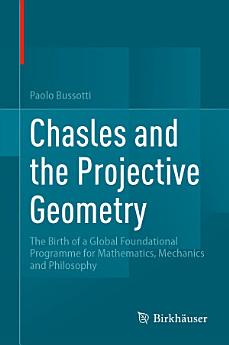Chasles and the Projective Geometry: The Birth of a Global Foundational Programme for Mathematics, Mechanics and Philosophy
Paolo Bussotti
Jul 2024 · Springer Nature
Ebook
572
Pages
reportRatings and reviews aren’t verified Learn More
About this ebook
This monograph meticulously examines the contributions of French mathematician Michel Chasles to 19th-century geometry. Through an in-depth analysis of Chasles' extensive body of work, the author examines six pivotal arguments which collectively reshape the foundations of geometry. Chasles introduces a novel form of polarity, termed "parabolic," to the graphic context, so expressing the metric properties by means of this specific polarity—a foundational argument. Beyond the celebrated "Chasles theorem," he extends his analysis to the movement of a rigid body, employing concepts derived from projective geometry. This approach is consistently applied across diverse domains. Chasles employs the same methodology to analyze systems of forces. The fourth argument examined by the author concerns the principle of virtual velocities, which can also be addressed through a geometric analysis. In the fifth chapter, Chasles' philosophy of duality is explained. It is grounded on theduality principles of projective geometry. Finally, the author presents Chasles’ synthetic solution for the intricate problem of ellipsoid attraction—the sixth and concluding chapter. Throughout these explorations, Chasles engages in a dynamic scientific dialogue with leading physicists and mathematicians of his era, revealing diverse perspectives and nuances inherent in these discussions. Tailored for historians specializing in mathematics and geometry, this monograph also beckons philosophers of mathematics and science, offering profound insights into the philosophical, epistemological, and methodological dimensions of Chasles' groundbreaking contributions. Providing a comprehensive understanding of Chasles' distinctive perspective on 19th-century geometry, this work stands as a valuable resource for scholars and enthusiasts alike.
About the author
Paolo Bussotti is Associate Professor in History of Science and Techniques at the University of Udine (Italy). His research areas are history of science and mathematics, in particular history of geometry and number theory between the 17th and the 19th centuries, and history of physics and astronomy in the 17th century. He is the author of more than 150 scientific publications, among which a monograph on the history of the method of infinite descent (number theory), From Fermat to Gauss. Indefinite descent and methods of reduction in Number Theory (2006), one on Leibniz’s planetary theory, The complex itinerary of Leibniz’s planetary theory (Birkhäuser, 2015) and one, written jointly with Prof. Brunello Lotti, titled Cosmology in the Early Modern Age. A Web of Ideas (Springer, 2022). He is the co-author (jointly with prof. R. Pisano) of many papers on the Geneva Edition of Newton’s Principia published in important journals dedicated to the history of science. Furthermore, he is reviewer for leading scientific journals and well-known reviewing services such as Zentralblatt für Mathematik.
Rate this ebook
Tell us what you think.
Reading information
Smartphones and tablets
Install the Google Play Books app for Android and iPad/iPhone. It syncs automatically with your account and allows you to read online or offline wherever you are.
Laptops and computers
You can listen to audiobooks purchased on Google Play using your computer's web browser.
eReaders and other devices
To read on e-ink devices like Kobo eReaders, you'll need to download a file and transfer it to your device. Follow the detailed Help Center instructions to transfer the files to supported eReaders.





